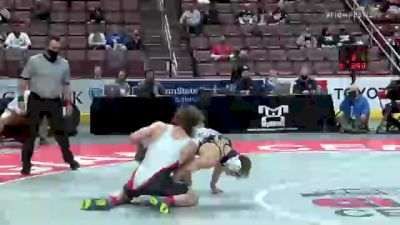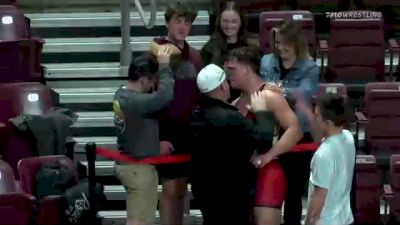Thoughts From Behind The Mic: PIAA AAA
Thoughts From Behind The Mic: PIAA AAA
Recap of the 2021 PIAA AAA State Wrestling Championships.

Unlock this article, live events, and more with a subscription!
Already a subscriber? Log In
It was a strange year. The PIAA State Championships weren’t any different. The PIAA did what they had to do to let the wrestlers compete. They should be commended for being flexible to arrange the schedule to have the postseason within the guidelines. Below I share my thoughts on the PIAA Championships as I observed from the matside announcers table.
Super-Region Breakdown
This observation started the minute the postseason adjustments were made. Everyone started to look how each weight class measured up in each super-region. It wasn’t an ideal system as the balance of power in some weights heavily favored one of the super-regions. Top eight guys were left at home this week because of the qualifying procedure. This happens in a normal year, but was accentuated by the super-region format.
| W1 | W2 | W3 | W4 | E1 | E2 | E3 | E4 | |
|---|---|---|---|---|---|---|---|---|
| 106 | 3 | 4 | 1 | 2 | 5 | 6 | 7 | 8 |
| 113 | 8 | 3 | 1 | 4 | 2 | 5 | 7 | 6 |
| 120 | 1 | 2 | 3 | 8 | 4 | 7 | 5 | 6 |
| 126 | 2 | 5 | 3 | 7 | 1 | 4 | 6 | 8 |
| 132 | 2 | 1 | 3 | 5 | 4 | 6 | 8 | 7 |
| 138 | 1 | 2 | 6 | 4 | 3 | 7 | 8 | 5 |
| 145 | 2 | 1 | 6 | 3 | 4 | 5 | 7 | 8 |
| 152 | 1 | 2 | 3 | 4 | 5 | 8 | 7 | 6 |
| 160 | 3 | 7 | 6 | 5 | 1 | 2 | 4 | 8 |
| 172 | 2 | 1 | 5 | 4 | 3 | 6 | 7 | 8 |
| 189 | 4 | 7 | 2 | 5 | 1 | 8 | 3 | 6 |
| 215 | 2 | 1 | 8 | 4 | 3 | 7 | 6 | 5 |
| 285 | 3 | 1 | 7 | 4 | 8 | 2 | 5 | 6 |
| 34 | 37 | 54 | 59 | 44 | 73 | 80 | 87 | |
| 2.62 | 2.85 | 4.15 | 4.54 | 3.38 | 5.62 | 6.15 | 6.69 | |
| 3.54 | 5.46 |
Balance showed up on the AA side with an average placement difference of only .04. That didn’t happen on the AAA side. When the alignments were announced many knew it was going to be quite lopsided in the West’s favor. The West average of 3.54 was almost two full placements ahead of the East Super-Regions average of 5.46.
The West Super-Region Champions had the lowest average placement at 2.62. Keep in mind that included a champion missing weight and being assigned 8th place points for our exercise. Both the East and West champions earned three titles each. The surprise came from the West second place finishers. Five state champions were second last week in the West Super-Region. Four of those five champions got revenge and defeated the West Super-Region Champion in the finals. The third place finishers out of the West almost match the champions from the East as two wrestlers finishing third in the West won PIAA State Championships.
Alejandro Herrera-Rondon Into Elite Club
On the AA side we looked at Brock McMillen joining the three-time champion, foru-time finalist club. Herrera-Rondon dropped an ultimate tiebreaker match to Partick Noonan (Stroudsburg) last season, keeping him off the four-time finalist list. This year I think he falls into two categories I used in my AA observations. He is the 52nd member of the three-time PIAA Champions Club. He also fits right in with Arrignton and Haines from the AA side as he was already a superstar, but separated himself from the field of high school talent.

Herrera-Rondon has always had the mat game and defensive abilities. This year he really showcased his improvement getting to legs and pressing the match as an offensive wrestler. He is going to be a fan favorite in Norman over the next few seasons.
2020 106lb Domination
Every time high school weight reallocation comes up there is a fierce debate about the starting weight class. It is shown to be the weight that produces the most forfeits. You have to remember it is also the only weight class that you can’t bump a wrestler from another weight class to fill the hole. The discussion ultimately turns into a history lesson as great 103 and 106lb brackets get mentioned. The weight class is a fertile ground for high level development. There is no denying the amount of talent that started their high school career at the lightest weight class. The 2020 106lb AAA bracket started to put their stamp on the discussion this year, and they have a strong case to keep the weight where it is for the little guys to develop their skills.
Last year 106lbs was widely regarded as a very good weight class. This year those guys really proved it as they grew into a range of weights. PIAA qualifiers from the 2020 106lb class won state championships at 113, 120, and 126lbs at the 2021 championships. You can add 132lbs to the list as Briar Priest(Hempfield Area) was knocked out of the postseason at the Southwest Region in 2020 by Vinny Kilkeary (Greater Latrobe). Priest won at 132lbs by knocking off Dylan Chappell (Seneca Valley). Chappell had made finals at 106lbs and 120lbs prior to this season.
Tyler Kasak (Bethlehem Catholic) was 5th in the 106b bracket a year ago losing a wild semifinal to Kilkeary. He defeated former 106lb champ Carter Dibert (Franklin Regional) in the 126lb title match.
Mac Church (Waynesburg) was 3rd in the bracket last year. He climbed to the top of the podium at 120lbs.
Jacob Van Dee (Erie Cathedral Prep) lost an overtime bout a year ago in the 106lb final. He didn’t let it go that route this year scoring a last second takedown to take the title at 113lbs.
Next time the debate comes up, remember this class of wrestlers. The skill is there, they just don’t have the size early in their high school career.
Stalling Is The Product Of Officiating
Throughout the day on Friday you heard rumblings about stalling. I should be more specific and say the lack of stalling being called. It boiled over into the AAA side on Saturday. Wrestlers will adapt to the rules and how they are being called. When you have a lead or believe you have the advantage one the mat later in the match there is no rational reason to engage and mix it up if there is no penalty for avoiding action.
I am not going to cite any examples. I am sure some of you have personal ties to a bout that you thought could have been called differently. You have to remember, the wrestlers are there to get their hand raised. They aren’t there to entertain or even wrestle an aggressive bout. They adapt to how the bout is officiated, and put themselves in the best position to win. What I will do is put forth some recommendations for officials and how to approach a match.
Call stalling early. This will change the behavior of the wrestlers in most cases. An early call grabs their attention and gives them a chance to adjust the pace of the match. When the officials wait until late in the match they have given the wrestlers a precedent of how much inactivity will be tolerated. The official has now painted themself into a corner. They will not have enough time to call stalling for a point to be awarded, and it will be inconsistent with the early match inactivity tolerance.
Officials want to stay out of the match and an early call seems counter intuitive. A stalling point midway through the second period is less influential on the bouts outcome than a point in the closing 20 seconds. The early call or even calls will change the complexion of the match early enough that the wrestlers have time to respond and put offensive points on the board. I like the forced passivity in freestyle of a scoreless match because it forces someone to wrestle with the mindset of a trailing wrestler. I think early stall calls with a consistent presence would create the same kind of urgency.
If Pennsylvania wants to remain on top of the high school wrestling world there needs to be change. The wrestlers develop when there are exchanges and they wrestle top level competition through tough positions. Both wrestlers become better from the action packed exchanges. The more tolerant the officials are of matches that only have one or two exchanges throughout the bout, the less development that will occur.
Kinney So Close To History
Sean Kinney (Nazareth) was settling his hips in sudden victory away from a title at 285lbs. He would have been the first in PIAA history at the UNL, 275lb, or 285lb weight class. Thomas Haines (Solanco) is the heaviest freshman champion, winning 215lbs in 2011.
Let's also appreciate the wrestler that did win the title. Nate Schon (Selinsgrove) is now a four-time medalist and two-time champion. He won the title with a torn ACL.
There has never been a three-time champion at the heaviest weight class. On the AA side John Rizzo (Richland) was in line to become the first, but wrestled at 220lbs his senior season. Kinney missed on this opportunity to re-write the history books, but he’ll have more opportunities.
